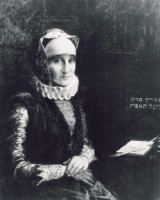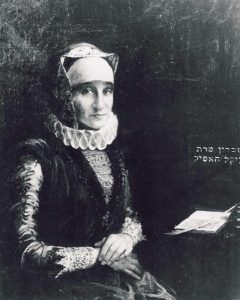Marion Kaplan on European Jewish Memoirs

(This photo shows Bertha Pappenheim, d.1936, costumed as
Gluckel of Hameln, d.1724, whose memoir she translated.)
**********
In a previous post, I interviewed New York University’s Dr. Marion Kaplan about Women and the Holocaust.
In this new post, Dr. Kaplan discusses books she uses for her course on European Jewish Memoirs.
Question: At New York University, you’ve headed seminars on European Jewish memoirs from Gluckel of Hameln through to modern times. Which of those memoirs might you especially recommend to the attention of the general reader, and why?
Answer: Students seem to enjoy this course because they like to read first person accounts. They home in on the chronologically earlier and the later memoirs, starting with Leon of Modena (1571-1648) whose Life of Judah describes this famous rabbi’s interest in alchemy and his scholarship while he bemoans his gambling and his debts at the same time.
Students enjoy this “time travel” as they do with Gluckel of Hameln, a businesswoman and mother of thirteen, who started her memoir in 1691, after her husband died. She describes her business dealings, her children’s marriages, and the surrounding Christian and Jewish worlds. Although students tend to be secular at NYU, they appreciate these two memoirs which focus on the “sins” of the authors, the role of God in their lives, and the constant trials of being Jewish in early modern Europe.
We cover memoirs written during the period in between — such as those from Jews in the nineteenth century — but students tend to prefer the later periods, including Holocaust memoirs and post-Holocaust or second-generation memoirs.
A favorite among Holocaust memoirs is Ruth Kluger’s Still Alive, describing her childhood in an increasingly Nazified Vienna, her deportation with her mother to Auschwitz, and her post war experiences in the United States where Jews and non-Jews alike did not understand – did not want to know – about her traumatic past.
Students also connect to second generation memoirs – of people born after the war to Holocaust survivors.
The following three books often attract young people, since these authors describe both the experiences of the survivor generation during the Holocaust and the transmission of knowledge and pain to the postwar generation:
1) Eva Hoffman’s Lost in Translation: Life in a New Language;
2) After such Knowledge: Memory, History, and the Legacy of the Holocaust;
3) Marianne Hirsch’s and Leo Spitzer’s Ghosts of Home: The Afterlife of Czernowitz in Jewish Memory.
**********
Dr. Marion Kaplan is a three-time winner of the National Jewish Book Award for her books:The Making of the Jewish Middle Class: Women, Family and Identity in Imperial Germany (New York, Oxford University Press, 1991); Between Dignity and Despair: Jewish Life in Nazi Germany (Oxford University Press, 1998); and Gender and Jewish History, co-edited with Deborah Dash Moore (Indiana, 2011).
Her other books include: The Jewish Feminist Movement in Germany: The Campaigns of the Jüdischer Frauenbund, 1904‑1938 (Greenwood Press, 1979); When Biology became Destiny: Women in Weimar and Nazi Germany co‑editor with Renate Bridenthal and Atina Grossmann (Monthly Review Press, 1984);The Marriage Bargain: Women and Dowries in European History, ed. (Institute for Research in History and the Haworth Press, 1985); Jewish Daily Life in Germany, 1618-1945, ed. (Oxford University Press, 2005); Jüdische Welten: Juden in Deutschland vom 18. Jahrhundert bis in die Gegenwart, co-editor with Beate Meyer (Wallstein Verlag, 2005); and Dominican Haven: The Jewish Refugee Settlement in Sosúa, 1940-1945 (New York, 2008), a Finalist, National Jewish Book Award. All of her monographs have been translated into German.
